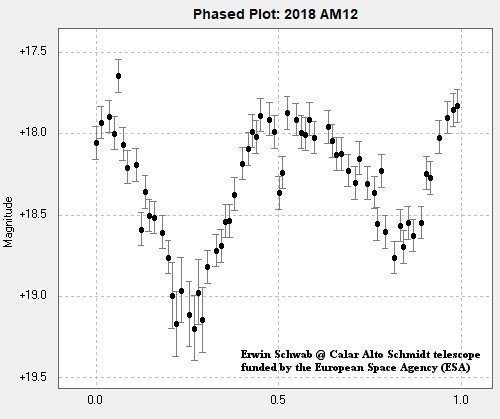Rotation period determination of the fast-rotating potentially hazardous asteroid 2018 AM12
The potentially hazardous Near Earth Asteroid 2018 AM12 was discovered by the Pan-STARRS 1 Survey, Haleakala, on 2018-01-15 (MPEC 2018-B27). About 38 hours later I did follow-up observations and found out a short time fluctuation of the brightness. I have collected data over about two hours, which resulted to the lightcurve shown below. The object is an extremely fast rotator with a rotation period of roughly 12.5 minutes. This fast period is unusual for an object of this size, since it is known that almost all objects larger than ~200 m tend to have periods longer than 2 hours (the so-called spin barrier). For data reduction was used the Software Astrometrica, for period analisis Peranso.

Sequence of fotos, taken on 2018-01-16 at the 0.8-m Schmidt telescope, Calar Alto, Spain by Erwin Schwab. Timespan of the sequence is about 22 minutes, which is almost 2 rotation periods. The shown field of view is ~8×8 arcmin. Exposure time per single frame was 30s.

rotation period graph of potentially hazardous Asteroid 2018 AM12, overlay of 7 rotation periods. Taken on 2018-01-16 at the 0.8-m Schmidt telescope, Calar Alto, Spain.

Location of 2018 AM12 in the „spin frequency/diameter“ diagram, assuming an ellipsoidal shape and an albedo of 0.2 (the albedo is not yet estimated with exact methods). The left end of the red line corresponds to 2018 AM12’s smallest diameter of an ellipsoidal shape (~129 meters), while the right end corresponds to the largest axis of 2018 AM12’s ellipsoidal shape (~387 meters). In this location of 2018 AM12 in the „spin frequency/diameter“ diagram, only rocky asteroids can exist, mere rubble piles can not exist due to the hight centrifugal forces. (Chart is from IAU Minor Planet Center Asteroid Lightcurve Photometry Database, modified by the author to show in the graph the location of 2018 AM12 for albedo 0.2).
- Thanks to Rolf Apitzsch (Observatory Wildberg) for checking the analysis
- The work was funded by the European Space Agency (ESA). There is also an article on ESA-Page
- The results have been publicated in the Minor Planet Bulletin Volume 45 (2018) 45-3 (Jul-Sep) pp 225
- Summary Data for 2018 AM12 can be found at Lightcurve Data Base LCDB
- The raw data points can be downloaded from Asteroid Lightcurve Photometry Database ALCDEF
- The results were presented at the minor planet meeting of Vereinigung der Sternfreunde in Salzburg (Austria) on 2019 06 14-16.
- The study received the Astronomy-Award 2019 of the Physikalischer Verein, Frankfurt – The rewarded work in german
